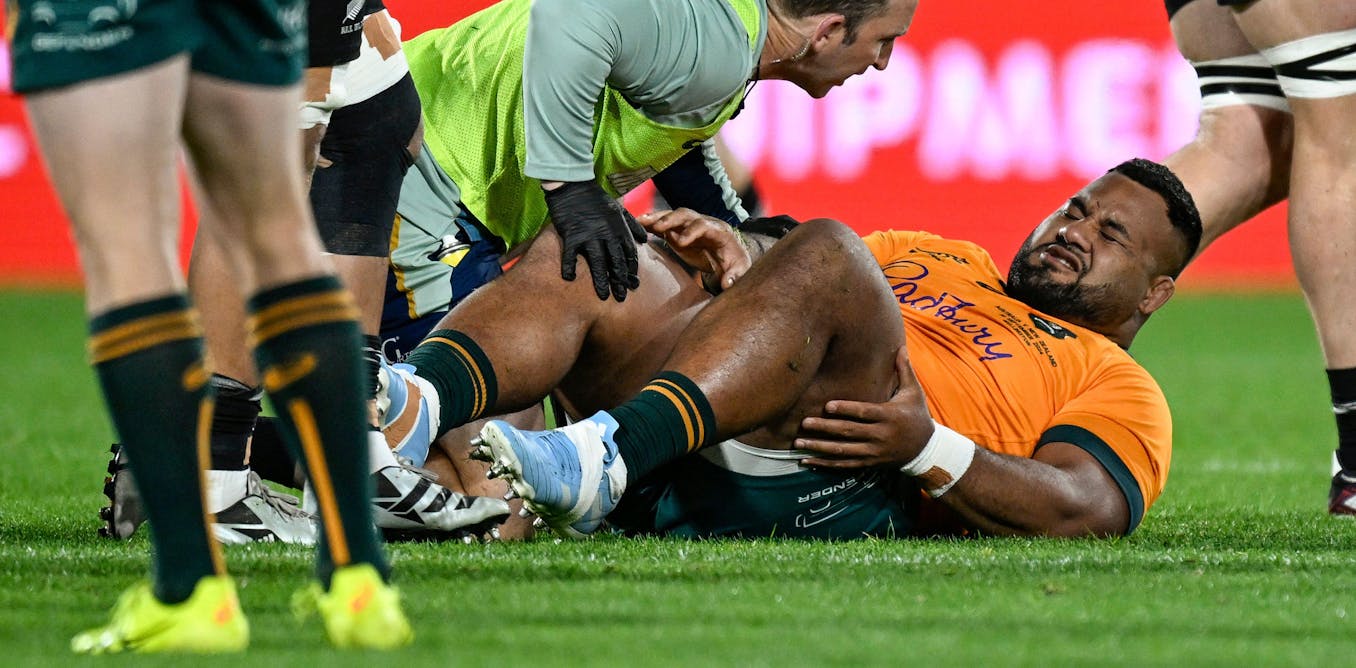Picture this: a rugby player sprints down the pitch with no opponent in sight, only to collapse mid-run. It’s a non-contact injury, a frustrating and often preventable setback that can sideline players for weeks or months. Rugby is a game of power, precision and relentless intensity – and it’s also a sport where injuries are ever-present.
But imagine a tool that could predict injuries before they happen, giving coaches the chance to intervene and keep players in the game. That’s the potential end-point of our latest research into AI and rugby injury.
Non-contact injuries to the legs account for nearly 50% of player absences in rugby union, often sidelining players for weeks or even months if they are severe. These injuries, such as hamstring, groin, thigh and calf strains, can be incredibly frustrating for both player and team. They disrupt training schedules, affect selection and team performance.
Previous studies have often fallen short because they focus on single-injury risk factors and miss the bigger picture. They may have looked at how isolated factors such as age, previous injuries or a player’s flexibility are associated with injury, but don’t always consider the complex interplay between these factors. It’s like trying to solve a puzzle by only looking at one piece at a time.
The reality is that an older player with poor joint flexibility who is returning from injury, for example, is at a higher risk of injury than an older player with better flexibility and no recent injury.
Cracking the code with AI
For our latest study, we took a different approach. We collected more than 1,700 weekly data points from full-time male rugby players over two seasons. These consisted of factors we know are associated with non-contact leg injuries – including body weight, changes in training intensity, fitness parameters like strength and cardiovascular fitness, past injuries, and performance in muscle and joint screening tests. We even looked at how sore players felt at the start of each day before training sessions.
We fed this information into a powerful AI system that can spot complex patterns. It sifted through all the data to find combinations of risk factors that were associated with players sustaining leg injuries.
The results were interesting. The AI model predicted severe non-contact leg injuries with 82% accuracy. So, for every ten such injuries, the model would have correctly predicted eight.
The model suggested that players were more at risk of injury when they had some combination of a reduction in hamstring and groin strength, reduced flexibility in their ankle joint, greater muscle soreness, and frequent changes in training intensity.
The model used other factors – such as a reduction in sprint time, greater body mass, and previous injuries and concussions – to predict non-contact ankle sprains with 75% accuracy. But while it also successfully predicted some other, less-severe leg injuries with similar (74%) accuracy, not all injuries were predicted with confidence – for example, hamstring and groin strains.
An early-warning AI system could provide coaches with crucial insights on which players might be at risk. Think of it as a hi-tech crystal ball, offering a glimpse into potential problems before they happen and enabling proactive measures to keep players on the field.
Coaches could use this information to create tailored training programmes that ensure players are consistently monitored and supported. Targeted interventions – such as exercises designed to address specific weaknesses or enhance mobility – may significantly reduce injury risks.
In theory, by optimising pre-season training through focused athlete screening, our study may offer clear and practical guidelines. These simple, cost-effective tools may enable coaches and medical staff to identify potential risks early, providing a proactive approach to player safety and performance.
This AI-powered approach isn’t just for rugby either. It could be used in any sport where data can be collected. Imagine personalised training plans and injury prevention strategies for every athlete, from football players to gymnasts. It could transform how athletes train and compete, helping them stay healthy and perform at their best.
As yet, AI is not used widely even in elite sport. But with the development of smart technology in watches that monitors training alongside other factors, it is conceivable that in time, it could be rolled out to recreational athletes too.
The future of injury prevention?
This research is just the first step, however. Scientists worldwide are already working on ways to make these AI models even more accurate, by including other risks to athletes such as psychological factors and indicators of how the body moves. They’re also looking at how different sports might have unique combinations of risk factors that need to be considered.
By combining the precision of AI with the insights of sports science and medicine, we stand on the brink of a revolution in injury prevention and performance optimisation. This approach may not only enhance player safety but unlock their full potential, redefining how athletes engage with the sports they love. With rugby as a proving ground, this innovation could pave the way for a safer and smarter future in sport.
The authors do not work for, consult, own shares in or receive funding from any company or organisation that would benefit from this article, and have disclosed no relevant affiliations beyond their academic appointment.
Source: View source




